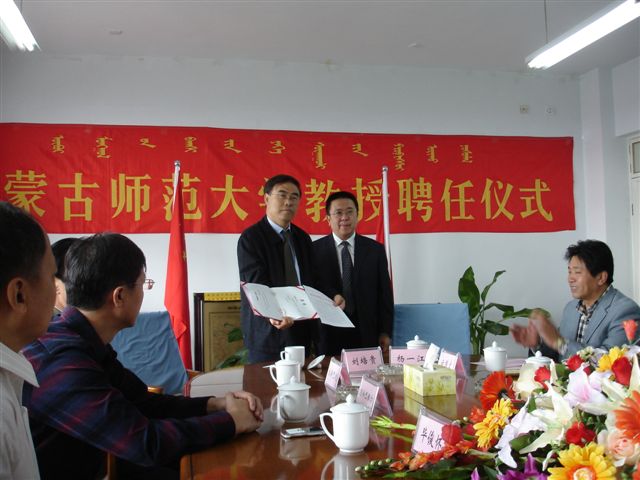September 5th to 28th, 2009, six members, including senior visiting scholar Dr. Wang Yun, researcher of New Zealand Plants and Food Research Institute, led by the KIB research group leader Prof. Liu Peigui, studied the fungi resources in desert and semi-desert regions of Northwest China and in the coniferous forests of cold temperature zone. The study has achieved fruitful results.
Although the desert and semi-desert regions of Northwest China has low vegetation coverage and poor eco-environmental condition, due to its unique climate, location and vegetation type, it plays a key role in the comprehensive understanding of current situation of fungi resources in China and the bio-geographical relation of different fungal flora between China and the rest of the world, especially Central and West Asia. However, our understanding of the fungi resources were limited due to the fungi research in this area was relatively insufficient. The purpose of this study was to understand the macro fungi in this region, especially the natural resources and status of those macro fungi that have important economic and ecological value, find fungal species (particularly underground fungi) which accrete with endemic plants in northwest desert and have important economic and ecological value and then, base on this, propose the measures of protecting and continuously using those economical fungi.
The expedition route was set from Urumqi in the west to Hohhot in the east, for a total trip of about 8 thousand kilometers. The fieldwork was divided into two stages. The first stage was in Xinjiang Uygur Autonomous Region and the route was along the middle section of TisnShan, then to the southeast, including the following places: Tianshan Nanshan Juhuatai, Tianshan large and small Tianchi lakes, Fukang, Mulei and Balikun. The major vegetation types studied were the cold temperate coniferous forests which were mainly consisted of the Tianshan spruce and Siberian larch that were located from middle and low mountains to Subalpine. The second stage started at Zhongwei(Shapotou), Ningxia Hui Autonomous Region. The route set off at Shapotou, passed through Tengger Desert and then came into Alashan, west of Inner Mongolia Autonomous Region. In this region, the team mostly studied the coniferous forest which was composed of Qinghai spruce forest in the northern section of Helan Mountain National Nature Reserve (Beisi) and pine in the southern section (Nansi). The team then studied Ulanbuh and the desert along the line of Bayanhaote (Alxa Zuoqi) to Jilantai and Wuhai and then entered Bayanzhuoer Union. In Bayanzhuoer Union, the team studied the Ordos Qipanjing National Nature Reserve, which is the protected area of Tetraena mongolia and Helianthemum soongolicum. In this stage, the main vegetation studied was the oil plants-Tetraena Mongolia, renowned as state-level protected species and the well-known living fossil-Helianthemum soongolicum, an ancient Mediterranean relict plant as well as its associated plant-traria sibirica, convolvulus tragacanthoides and Bawang flower, which were all desert and semi-desert vegetation types. After arriving at Baotou and Hohhot on September 19th, the expedition team separately carried out academic exchanges with experts from Baotou Normal University, Inner Mongolia University, Inner Mongolia Normal University and Inner Mongolia Agricultural University and visited the botanical gardens, the relevant institutions and laboratories. Prof. Liu Peigui and Dr. Wang Yun respectively made academic reports on the title of 'Talking about the mycorrhizal edible fungus' and 'The status and sustainable use of mycorrhizal edible fungus in China' at Inner Mongolia University. On September 25th, Prof. Liu Peigui was honored to be engaged as external professor by Inner Mongolia Normal University.
This expedition has totally collected 110 pieces, 34 genera of fungal specimens, separated 66 pieces of microorganisms and gathered 15 pieces of mycorrhizal samples and 10 special and important plants. The important and economic-valued groups collected included Tuber, Hydnotrya, Rhizopogon, Schizostoma laceratus Ehrenb, Tulost, Montagnea arenaria, Lactarius, Cortinarius and so on. The follow-up study of these specimens and mycorrhizal materials will be expected to enhance the comprehensive understanding of the fungi resources in this region.
The expedition received strong support and assistance from researcher Pan Borong, Xinjiang Institute of Ecology and Geography of Chinese Academy of Sciences and Prof. Liang Cunzhu, College of Life Sciences of Inner Mongolia University. Xu Jiping and Ban Weiqiang, Xinjiang Institute of Ecology and Geography, participated in the investigation in the section of Xinjiang. Professor Liang Cunzhu, Inner Mongolia University, participated in the investigation in the section of Inner Mongolia. Their participation made up the knowledge of endemic plants, brought fruitful results to this expedition and laid the necessary foundation for the next step of the research work.



|
|




